Special Report
10 Kinds of Edible Eggs That Don't Come From Chickens

Published:
Last Updated:

Eggs are often called nature’s perfect food. Unless you’re allergic to them — they’re among the most common childhood allergies, but most youngsters grow out of their allergy before adolescence — there’s not much wrong with them. They’re self-contained, sometimes cited as an example of good natural packaging design. They’re inexpensive, currently about $2.70 a dozen — 22.5 cents apiece — because supermarkets typically sell them cheaply, as a loss leader to bring customers into the store.
They’re also, of course, incredibly versatile. They can be eaten hard- or soft-boiled, scrambled, fried, poached; in omelettes and quiche, salad dressings, and custards. They go into pasta dough and mayonnaise, ice cream and all kinds of baked goods. They’re the basis of classic French sauces like hollandaise and béarnaise and are essential for spaghetti alla carbonara and traditional in fried rice and pad Thai. They’re used in virtually every cuisine. No wonder Americans consume more than 276 eggs per person every year, either alone or in baked goods, sauces, etc.
Click here for 10 kinds of edible eggs that don’t come from chickens.
All those eggs, however, are overwhelmingly those that come from chickens. There are about 9,000 species of birds, and all of them lay eggs. All are also most likely edible (the possible exceptions being those of a couple of species in Papua New Guinea, whose skin and feathers are toxic and whose eggs might be). Reptiles and amphibians lay eggs, too, as do fish, and these, too, are edible. Fish roe, otherwise sometimes known as caviar, are a pricey delicacy (see No. 9).
The average home cook or restaurant chef isn’t likely to start frying up the eggs of robins or vultures, much less garter snakes, of course, but a number of unconventional bird eggs are finding their way into more and more restaurants and markets — both farmers’ markets and specialty supermarkets — these days. These eggs may be smaller or larger (in some cases much larger) than chicken eggs, and some of them have shells that are thicker than the norm, making them harder to crack. In general, the yolks are larger in proportion to the whites than with chicken eggs, and the flavor of these eggs is often richer. They’re definitely worth trying.

1. Duck
> Weight: 2.5 ounces
> Calories: 130
> Fat: 9.6 grams
> Protein: 9 grams
The duck egg is like a ramped-up chicken egg, typically about 50% larger, with a bigger yolk and a higher proportion of yolk to white than with a chicken’s egg. Duck eggs vary in color — white, gray, green, brown, black — depending on the breed of duck that laid them. The bird’s diet affects the flavor, but in general, duck eggs taste like a richer version of chicken eggs. In general, duck eggs can be eaten just like chicken eggs, though they may take some experimentation when used in baking because of their size and higher fat content. One downside to duck eggs is that at about 619 milligrams of cholesterol, a single egg contains just over twice the recommended U.S. Food and Drug Administration daily limit of 300 milligrams of cholesterol. To compare, a large chicken egg contains about 211 milligrams of cholesterol.
[in-text-ad]
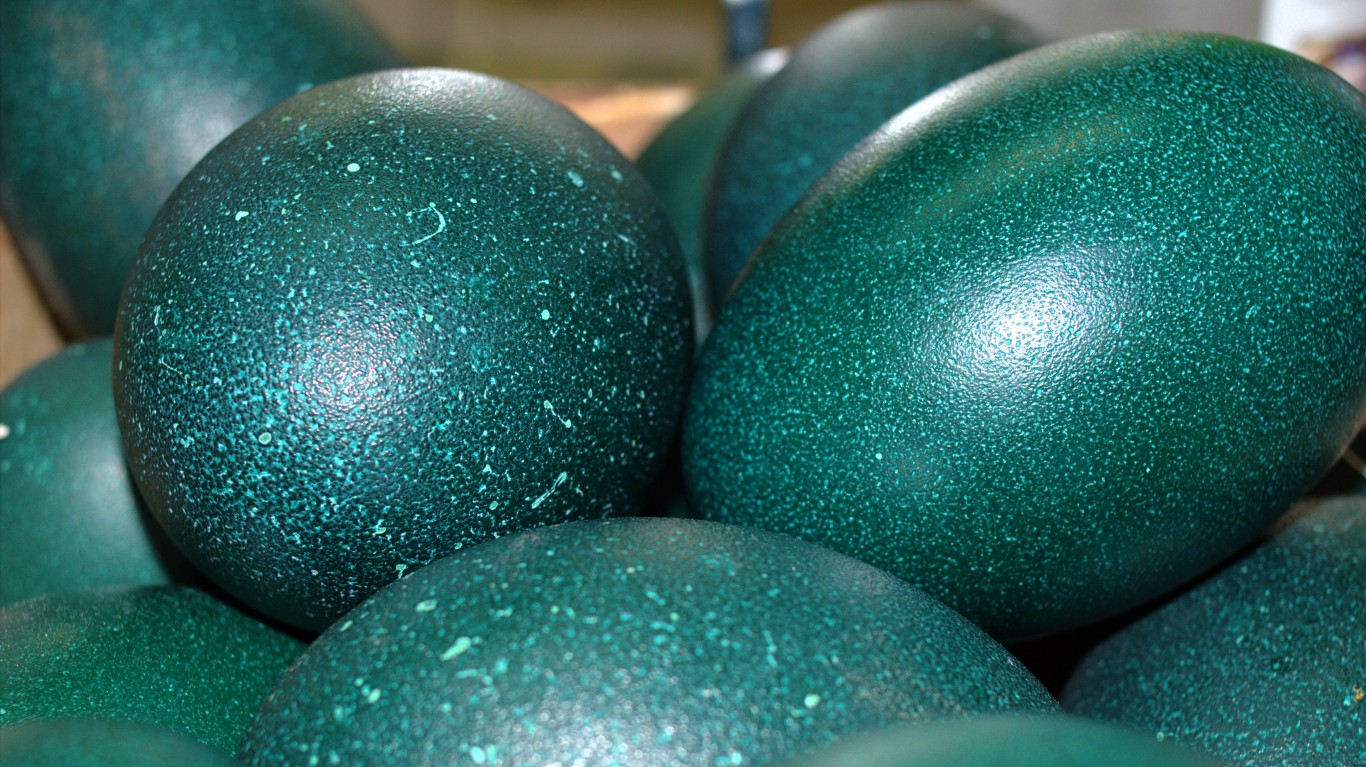
2. Emu
> Weight: 21.5 ounces
> Calories: 134
> Fat: 38 grams
> Protein: 72 grams
The emu, a long-neck ratite bird (a class of flightless avians) and the second largest bird on Earth by height — sometimes reaching more than 6 feet — is native to Australia. It is the country’s national bird. Its eggs are striking in appearance — big (about 3 ½ by 6 inches) and dark mottled green, sometimes tending toward black. From a distance, they resemble Hass avocados. Each one is the size of about a dozen hen’s eggs. Both the yolk and white are unusually thick, and the eggs are considered the richest in flavor of any edible bird egg. They lend themselves well to omelettes, among other dishes.

3. Goose
> Weight: 5 ounces
> Calories: 267
> Fat: 19 grams
> Protein: 20 grams
“Goose egg” is a metaphor for zero, a reference to its shape, and for a bump on the head. The actual goose egg is about three times the size of a chicken egg but has roughly six times the cholesterol and almost four times the calories. On the plus side, it is proportionately higher in A, D, E, and B vitamins, iron, and selenium. Several years ago, NPR writer and editor Eliza Barclay organized a tasting of hard-boiled chicken, duck, quail, and goose eggs, in which the goose egg finished last, evoking comments like “funky,” “weird,” and “bland.” Other tasters, though, find them either similar in flavor to chicken eggs or considerably richer — like a double-yolk chicken egg, some say.
[Need Manual Image]

4. Guinea hen
> Weight: 1.4 ounces
> Calories: 45
> Fat: 3.5 grams
> Protein: 15 grams
The guinea hen, or guinea fowl, is a bird of West African origins that looks a little like a smaller turkey without the wattle. The bird is favored for its meat (it’s common on French menus under the name “pintade”), but guinea hen eggs, speckled brown and slightly smaller than chicken eggs, have been described as delicious and the best of all bird eggs. Guinea hens are often allowed to range freely around barnyards, eating grubs and worms, and this gives their eggs added flavor.
[in-text-ad-2]

5. Gull
> Weight: 3.5 ounces
> Calories: 139
> Fat: 9.7 grams
> Protein: 11.7 grams
The eggs of the laughing or black-headed seagull (Chroicocephalus ridibundus) are considered a springtime delicacy in the U.K. The legal season for collecting the eggs of this wild bird runs from April 1 to May 15 each year. The eggs can be collected only in six defined areas, mostly in Hampshire, on England’s southern coast, and there are only a handful of eggers licensed to collect the eggs. Gull eggs are smaller than the chicken equivalent, but they have a stronger flavor, sometimes described as gamy. The eggs were traditionally eaten hard-boiled, with celery salt, but today chefs in London and other parts of the country might prepare the eggs with artichokes, smoked salmon and caviar, or asparagus, among other delicacies.
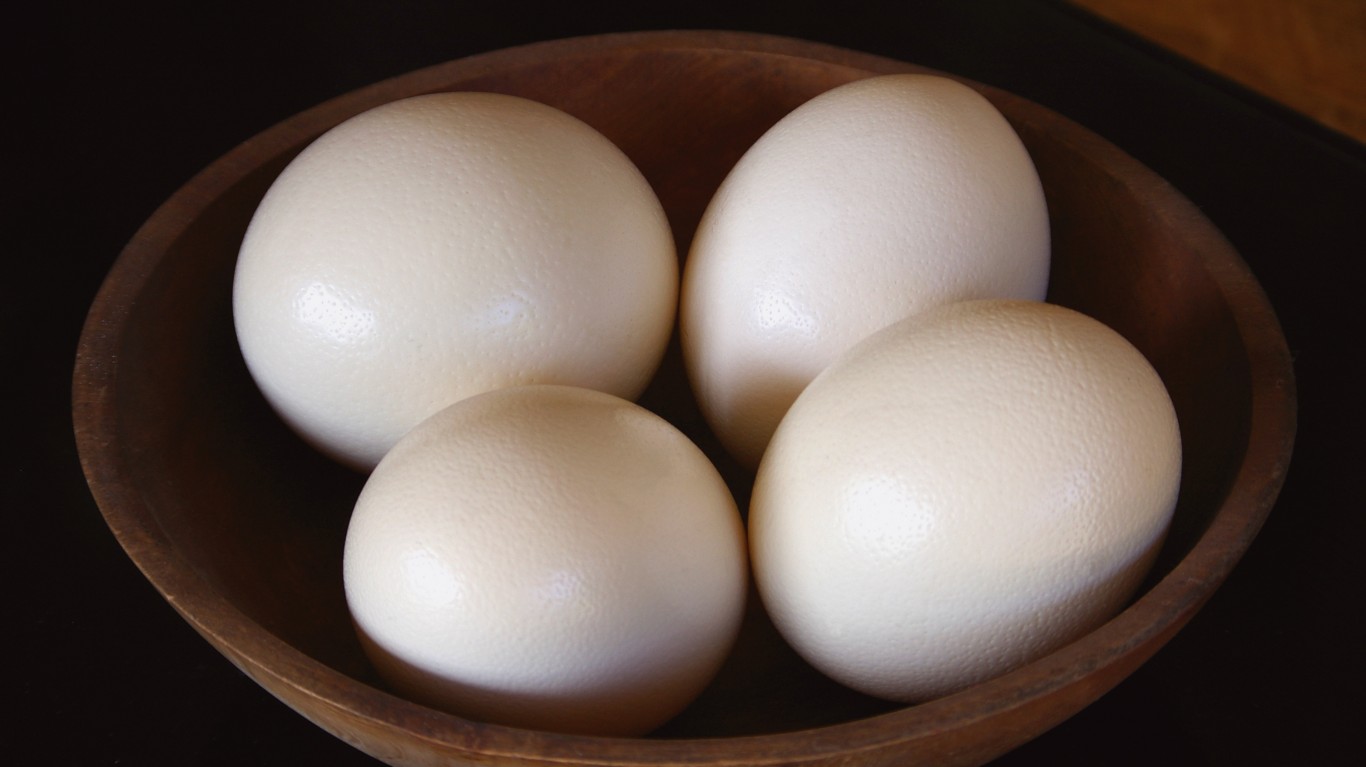
6. Ostrich
> Weight: 48 ounces
> Calories: 2,000
> Fat: 120 grams
> Protein: 168 grams
Like its cousin the emu (see No. 2), the ostrich is a ratite (a kind of flightless avian). Native to Africa, it is the tallest bird in the world, measuring up to 9 feet in height — almost half of which is neck. Its egg is the largest bird’s egg in the world, though also the smallest in relation to the size of the bird that lays it. As might be expected with an egg this big — the approximate equivalent of 24 chicken eggs — the shell is thick (about the thickness of the side of a teacup) and hard, and thus not easy to crack. The recommended technique is to score a line in the shell with a hacksaw or strong serrated knife, then stick the tip of a chisel or screwdriver in the fissure and tap it with a mallet. To hard-boil an ostrich egg would take about an hour-and-a-half. The flavor of the egg is said to be similar to that of a chicken egg but with a buttery character.
[in-text-ad]
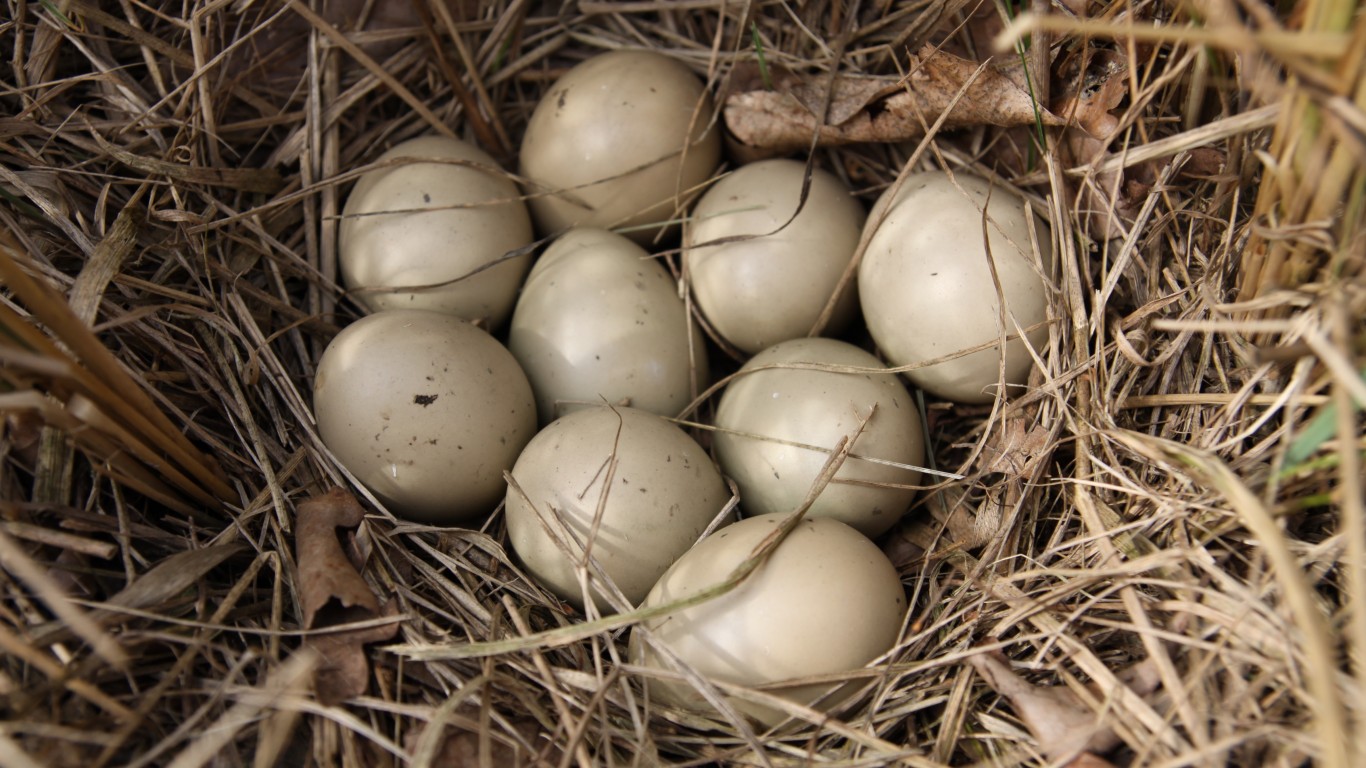
7. Pheasant
> Weight: 2.8 ounces
> Calories: 135
> Fat: 9.4 grams
> Protein: 11 grams
The pheasant is a popular game bird, hunted in the wild, but it’s also farm-raised, and its eggs are sometimes collected and sold for eating. The pheasant egg, generally brown, beige, or pale green in color, is smaller than a chicken egg but larger than a quail egg. The yolks tend to be comparatively large, deep yellow in color, and rich in flavor. Pheasant eggs can be used like hen eggs, in breakfast dishes and such, but at least one English purveyor suggests treating them like gull eggs — presumably just hard-boiling them and eating them with celery salt).
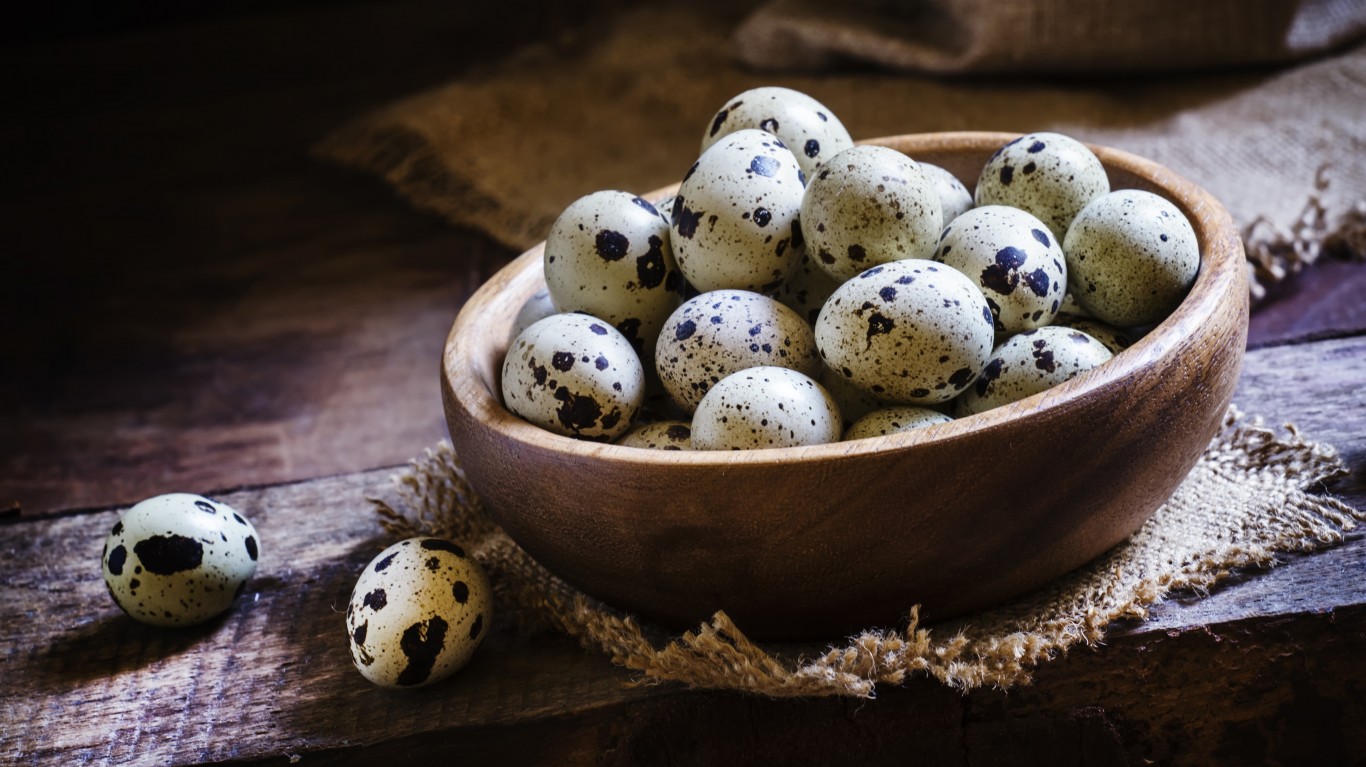
8. Quail
> Weight: 0.3 ounce
> Calories: 14
> Fat: 1 gram
> Protein: 1.2 grams
In recent years, eggs in various forms have found their way increasingly onto fine dining menus. While these are often chicken eggs, more and more chefs are also using the richly flavored little ones, about the size of large olives or grape tomatoes, that come from the tasty little birds known as quail. They’re the egg of the moment in restaurants around the world, in fact. Chefs use them for eggs Benedict, wrap them in bacon, add them to Caesar salad. In Japan, they’re incorporated into sushi or grilled on skewers as yakitori. In Spain, they’re marinated in sherry vinegar or pan-fried and served on toasted bread with cured ham as tapas. Though they’re small, they have large yolks and can be used in cooking just like most other eggs — though it takes five or six of them to equal the volume of a single hen’s egg.
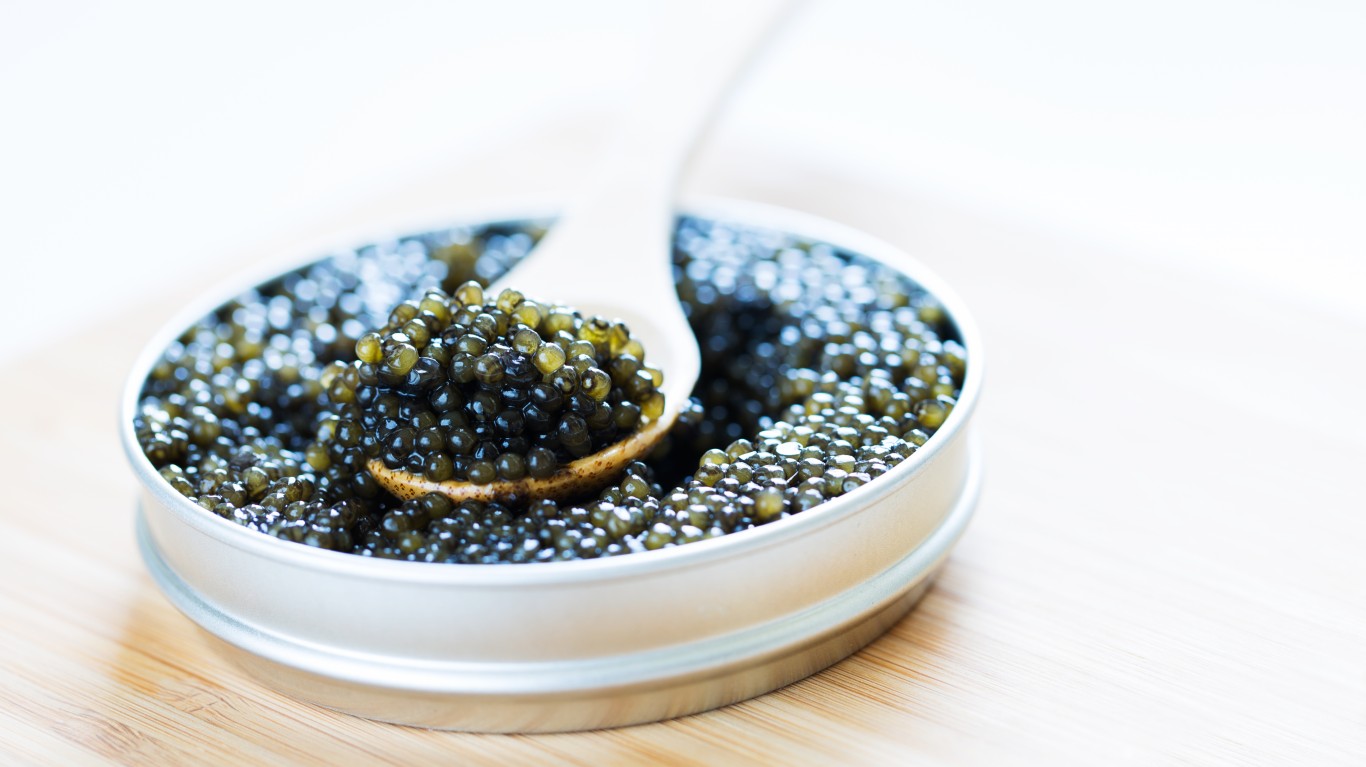
9. Sturgeon
> Weight: 1 ounce (typical serving)
> Calories: 75
> Fat: 5 grams
> Protein: 7 grams
Unlike the other birds’ eggs on this list, sturgeon roe — better know as caviar — are the eggs of a fish and can’t be used like chicken eggs. They’re tiny (BB-size), shell-less, and mostly pearly gray to brown or black in color. They are typically eaten on toast points or tiny pancakes known as blini, sometimes with sour cream and other garnishes. Classic caviar is a pricey delicacy, harvested and processed (with salt and sometimes borax as a preservative) from sturgeon in, most famously, the Caspian Sea in Central Asia, a body of water bordered by Russia, Iran, and three former Soviet republics. The fish live in some nearby lakes and rivers, too. Today, exports of caviar from that region are banned or limited due to overfishing of the sturgeon, but roe from sturgeon and related fish from other parts of the world — including the U.S., China, Spain, Italy, and Germany — is now available, as are the eggs of many other kinds of fish, including flying fish (the tobiko of sushi bars), lumpfish, whitefish, trout, salmon, and tuna.
[in-text-ad-2]
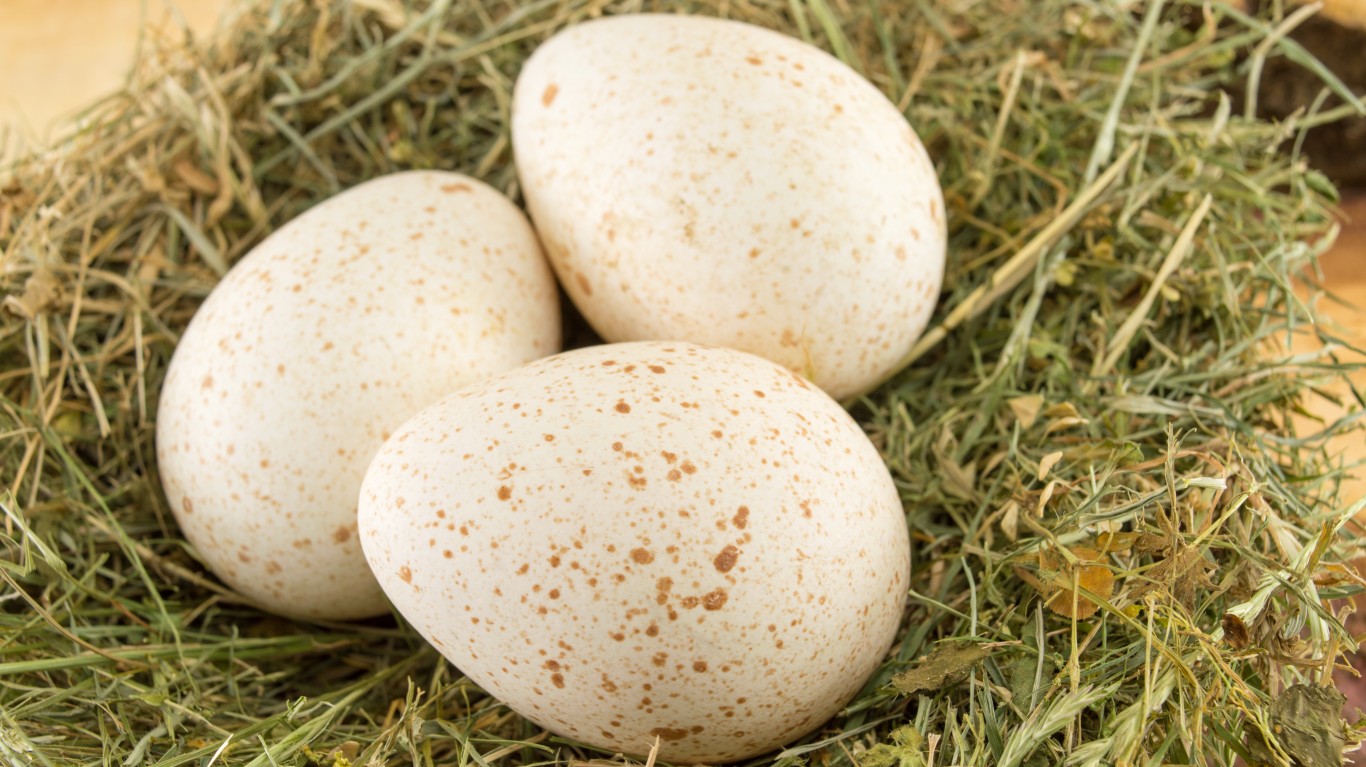
10. Turkey
> Weight: 3.5 ounces
> Calories: 171
> Fat: 12 grams
> Protein: 14 grams
There’s no shortage of turkeys in America — the USDA forecasts that some 240 million of the birds will be raised here this year, and turkey is the fourth most popular meat in the country after chicken, beef, and pork — but turkey eggs are rare on our tables. This is partly the turkey’s fault. Because turkeys have a longer life cycle than chickens, they don’t start laying eggs until they’re about 7 months old (chickens begin laying eggs about 2 months earlier), and then they typically lay only a couple of them a week, while hens and ducks lay about one a day. Because turkeys are bigger than chickens, they need more food, too. Therefore, there’s not much impetus for turkey farmers to get into the egg market as they’d rather breed more birds. However, the eggs, about twice the size of chicken eggs, were once popular in English and American cookery (turkey egg omelettes were on the menu at the legendary Delmonico’s in Manhattan in the late 1800s), and like many other eggs that don’t come from hens, they are said to be richer in flavor.
Want retirement to come a few years earlier than you’d planned? Or are you ready to retire now, but want an extra set of eyes on your finances?
Now you can speak with up to 3 financial experts in your area for FREE. By simply clicking here you can begin to match with financial professionals who can help you build your plan to retire early. And the best part? The first conversation with them is free.
Click here to match with up to 3 financial pros who would be excited to help you make financial decisions.
Thank you for reading! Have some feedback for us?
Contact the 24/7 Wall St. editorial team.